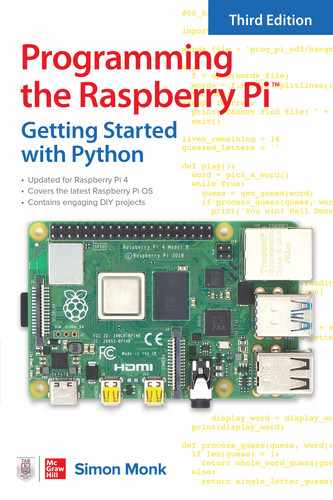4
Strings, Lists, and Dictionaries
This chapter could have had “and Functions” added to its title, but the title was already long enough. In this chapter, you will first explore and play with the various ways of representing data and adding some structure to your programs in Python. You will then put everything you learned together into the simple game of Hangman, where you have to guess a word chosen at random by asking whether that word contains a particular letter.
The chapter ends with a reference section that tells you all you need to know about the most useful built-in functions for math, strings, lists, and dictionaries.
String Theory
No, this is not the Physics kind of String Theory. In programming, a string is a sequence of characters you use in your program. In Python, to make a variable that contains a string, you can just use the regular = operator to make the assignment, but rather than assigning the variable a number value, you assign it a string value by enclosing that value in single quotes, like this:
>>> book_name = 'Programming Raspberry Pi'
If you want to see the contents of a variable, you can do so either by entering just the variable name into the Python Shell or by using the print command, just as we did with variables that contain a number:

There is a subtle difference between the results of each of these methods. If you just enter the variable name, Python puts single quotes around it so that you can tell it is a string. On the other hand, when you use print, Python just prints the value.
NOTE You can also use double quotes to define a string, but the convention is to use single quotes unless you have a reason for using double quotes (for example, if the string you want to create has an apostrophe in it).
You can find out how many characters a string has in it by doing this:
![]()
You can find the character at a particular place in the string like so:
![]()
Two things to notice here: first, the use of square brackets rather than the parentheses that are used for parameters and, second, that the positions start at 0 and not 1. To find the first letter of the string, you need to do the following:
![]()
If you put a number in that is too big for the length of the string, you will see this:

This is an error, and it’s Python’s way of telling us that we have done something wrong. More specifically, the “string index out of range” part of the message tells us that we have tried to access something that we can’t. In this case, that’s element 100 of a string that is only 24 characters long.
You can chop lumps out of a big string into a smaller string, like this:
![]()
The first number within the brackets is the starting position for the string we want to chop out, and the second number is not, as you might expect, the position of the last character you want, but rather the last character plus 1.
As an experiment, try and chop out the word raspberry from the title. If you do not specify the second number, it will default to the end of the string:
![]()
Similarly, if you do not specify the first number, it defaults to 0.
Finally, you can also join strings together by using + operator. Here’s an example:
![]()
Lists
Earlier in the book when you were experimenting with numbers, a variable could only hold a single number. Sometimes, however, it is useful for a variable to hold a list of numbers or strings, or a mixture of both—or even a list of lists. Figure 4-1 will help you to visualize what is going on when a variable is a list.
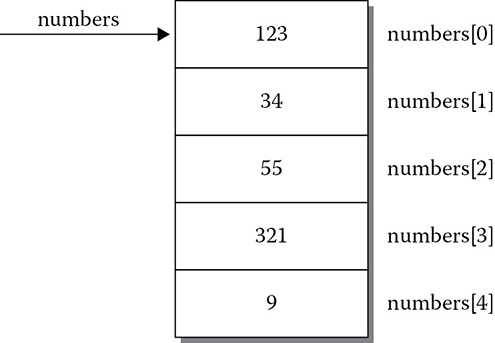
Figure 4-1 A list.
Lists behave rather like strings. After all, a string is a list of characters. The following example shows you how to make a list. Notice how len works on lists as well as strings:
![]()
Square brackets are used to indicate a list, and just like with strings we can use square brackets to find an individual element of a list or to make a shorter list from a bigger one:

What’s more, you can use = to assign a new value to one of the items in the list, like this:
![]()
This changes the first element of the list (element 0) from 123 to just 1.
As with strings, you can join lists together using the + operator:
![]()
If you want to sort the list, you can do this:
![]()
To remove an item from a list, you use the command pop, as shown next. If you do not specify an argument to pop, it will just remove the last element of the list and return it.

If you specify a number as the argument to pop, that is the position of the element to be removed. Here’s an example:

As well as removing items from a list, you can also insert an item into the list at a particular position. The function insert takes two arguments. The first is the position before which to insert, and the second argument is the item to insert.

When you want to find out how long a list is, you use len(numbers), but when you want to sort the list or “pop” an element off the list, you put a dot after the variable containing the list and then issue the command, like this:
numbers.sort()
These two different styles are a result of something called object orientation, which we will discuss in the next chapter.
Lists can be made into quite complex structures that contain other lists and a mixture of different types—numbers, strings, and logical values. Figure 4-2 shows the list structure that results from the following line of code:
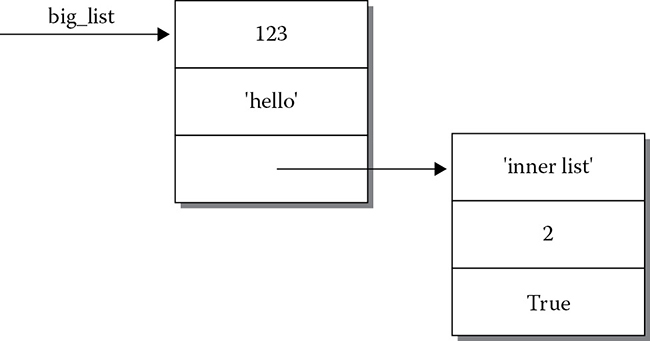
Figure 4-2 A complex list.
![]()
You can combine what you know about lists with for loops and write a short program that creates a list and then prints out each element of the list on a separate line:

Here’s the output of this program:
![]()
Functions
When you are writing small programs like the ones we have been writing so far, they only really perform one function, so there is little need to break them up. It is fairly easy to see what they are trying to achieve. As programs get larger, however, things get more complicated and it becomes necessary to break up your programs into units called functions. When we get even further into programming, we will look at other ways still of structuring our programs using classes and modules.
Many of the things I have been referring to as commands are actually functions that are built into Python. Examples of this are range and print.
The biggest problem in software development of any sort is managing complexity. The best programmers write software that is easy to look at and understand and requires very little in the way of extra explanation. Functions are a key tool in creating easy-to-understand programs that can be changed without difficulty or risk of the whole thing falling into a crumpled mess.
A function is a little like a program within a program. We can use it to wrap up a sequence of commands we want to do. A function that we define can be called (used) from anywhere in our program and will contain its own variables and its own list of commands. When the commands have been run, we are returned to just after wherever it was in the code we called the function in the first place.
As an example, let’s create a function that simply takes a string as an argument and adds the word please to the end of it. Load the following file—or even better, type it in to a new editor window—and then run it to see what happens:

The function starts with the keyword def. This is followed by the name of the function, which follows the same naming conventions as variables. After that come the parameters inside parentheses and separated by commas if there are more than one. The first line must end with a colon.
Inside the function, we are using a new variable called polite_sentence that takes the parameter passed into the function and adds “please” to it (including the space at the start). This variable can only be used from inside the function.
The last line of the function is a return command. This specifies what value the function should give back to the code that called it. This is just like trigonometric functions such as sin, where you pass in an angle and get back a number. In this case, what is returned is the value in the variable polite_sentence.
To use the function, we just specify its name and supply it with the appropriate arguments. A return value is not mandatory, and some functions will just do something rather than calculate something. For example, we could write a rather pointless function that prints “Hello” a specified number of times:
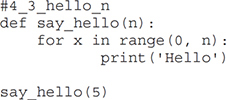
This covers the basics of what we will need to do to write our game of Hangman. Although you’ll need to learn some other things, we can come back to these later.
Hangman
Hangman is a word-guessing game, usually played with pen and paper. One player chooses a word and draws a dash for each letter of the word, and the other player has to guess the word. They guess a letter at a time. If the letter guessed is not in the word, they lose a life and part of the Hangman’s scaffold is drawn. If the letter is in the word, all occurrences of the letter are shown by replacing the dashes with the letters.
We are going to let Python think of a word and we will have to guess what it is. Rather than draw a scaffold, Python is just going to tell us how many lives we have left.
You are going to start with how to give Python a list of words to choose from. This sounds like a job for a list of strings:
![]()
The next thing the program needs to do is to pick one of those words at random. We can write a function that does that and test it on its own:


Run this program a few times to check that it is picking different words from the list. The ‘choice’ function from the ‘random’ module will, very helpfully, pick one of the items in the list at random.
This is a good start, but it needs to fit into the structure of the game. The next thing to do is to define a new variable called lives_remaining. This will be an integer that we can start off at 14 and decrease by 1 every time a wrong guess is made. This type of variable is called a global variable, because unlike variables defined in functions, we can access it from anywhere in the program.
As well as a new variable, we are also going to write a function called play that controls the game. We know what play should do, we just don’t have all the details yet. Therefore, we can write the function play and make up other functions that it will call, such as get_guess and process_guess, as well as use the function pick_a_word we’ve just written. Here it is:
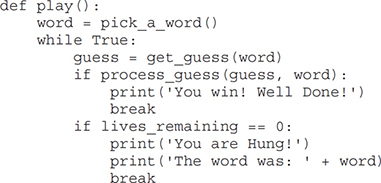
A game of Hangman first involves picking a word. There is then a loop that continues until either the word is guessed (process_guess returns True) or lives_remaining has been reduced to zero. Each time around the loop, we ask the user for another guess.
We cannot run this at the moment because the functions get_guess and process_guess don’t exist yet. However, we can write what are called stubs for them that will at least let us try out our play function. Stubs are just versions of functions that don’t do much; they are stand-ins for when the full versions of the functions are written.
![]()

The stub for get_guess just simulates the player always guessing the letter a, and the stub for process_guess always assumes that the player guessed wrong and, thus, decreases lives_remaining by 1 and returns False to indicate that they didn’t win.
The stub for process_guess is a bit more complicated. The first line tells Python that the lives_remaining variable is the global variable of that name. Without that line, Python assumes that it is a new variable local to the function. The stub then reduces the lives remaining by 1 and returns False to indicate that the user has not won yet. Eventually, we will put in checks to see if the player has guessed all the letters or the whole word.
Open the file 04_05_hangman_play.py and run it. You will get a result similar to this:
![]()
What happened here is that we have whizzed through all 14 guesses very quickly, and Python has told us what the word was and that we have lost.
All we need to do to complete the program is to replace the stub functions with real functions, starting with get_guess, shown here:

The first thing get_guess does is to tell the player the current state of their efforts at guessing (something like “c--c--n”) using the function print_word_with_blanks. This is going to be another stub function for now. The player is then told how many lives they have left. Note that because we want to append a number (lives_remaining) after the string Lives Remaining:, the number variable must be converted into a string using the built-in str function.
The built-in function input prints the message in its parameter as a prompt and then returns anything that the user types.
Finally, the get_guess function returns whatever the user has typed.
The stub function print_word_with_blanks just reminds us that we have something else to write later:
![]()
Open the file 04_06_hangman_get_guess.py and run it. You will get a result similar to this:
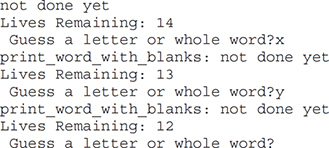
Enter guesses until all your lives are gone to verify that you get the “losing” message.
Next, we can create the proper version of print_word_with_blanks. This function needs to display something like “c--c--n,” so it needs to know which letters the player has guessed and which they haven’t. To do this, it uses a new global variable (this time a string) that contains all the guessed letters. Every time a letter is guessed, it gets added to this string:
guessed_letters = ''
Here is the function itself:
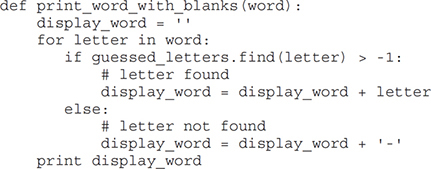
This function starts with an empty string and then steps through each letter in the word. If the letter is one of the letters that the player has already guessed, it is added to display_word; otherwise, a hyphen (-) is added. The built-in function find is used to check whether the letter is in the guessed_letters. The find function returns -1 if the letter is not there; otherwise, it returns the position of the letter. All we really care about is whether or not it is there, so we just check that the result is greater than -1. Finally, the word is printed out.
Currently, every time process_guess is called, it doesn’t do anything with the guess because it’s still a stub. We can make it a bit less of a stub by having it add the guessed letter to guessed_letters, like so:

Open the file 04_07_hangman_print_word.py and run it. You will get a result something like this:
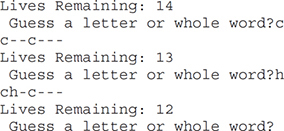
It’s starting to look like the proper game now. However, there is still the stub for process_guess to fill out. We will do that next:

When the player enters a guess, they have two choices: They can either enter a single-letter guess or attempt to guess the whole word. In this method, we just decide which type of guess it is and call either whole_word_guess or single_letter_guess. Because these functions are both pretty straightforward, we will implement them directly rather than as stubs:
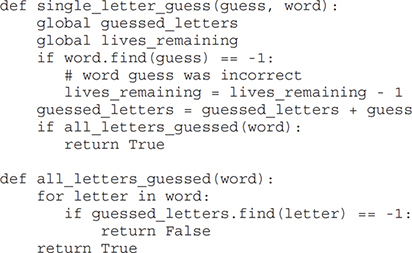
The function whole_word_guess is actually easier than the single_letter_guess function:

All we have to do is compare the guess and the actual word to see if they are the same when they are both converted to lowercase. We convert both to lowercase, so that it does not matter if the guessed word included some letters as capitals. We could just as easily convert both to uppercase and it would still work. If they are not the same, a life is lost. The function returns True if the guess was correct; otherwise, it returns False.
That’s the complete program. Open up 04_08_hangman_full.py in the Mu editor and run it. The full listing is shown here for convenience:

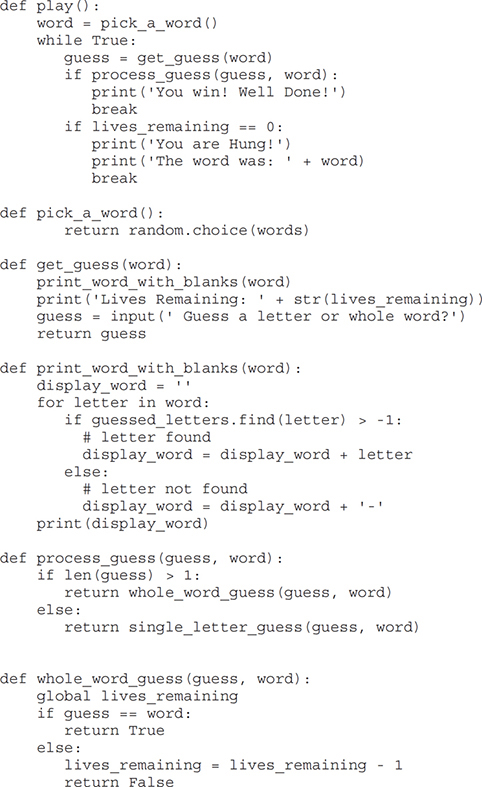

The game as it stands has a few limitations. First, it is case sensitive, so you have to enter your guesses in lowercase, the same as the words in the words array. Second, if you accidentally type aa instead of a as a guess, it will treat this as a whole-word guess, even though it is too short to be the whole word. The game should probably spot this and only consider guesses the same length as the secret word to be whole-word guesses.
As an exercise, you might like to try and correct these problems. Hint: For the case-sensitivity problem, experiment with the built-in function lower. You can look at a corrected version in the file 04_08_hangman_full_solution.py.
Dictionaries
Lists are great when you want to access your data starting at the beginning and working your way through, but they can be slow and inefficient when they get large and you have a lot of data to trawl through (for example, looking for a particular entry). It’s a bit like having a book with no index or table of contents. To find what you want, you have to read through the whole thing.
Dictionaries, as you might guess, provide a more efficient means of accessing a data structure when you want to go straight to an item of interest. When you use a dictionary, you associate a value with a key. Whenever you want that value, you ask for it using the key. It’s a little bit like how a variable name has a value associated with it; however, the difference is that with a dictionary, the keys and values are created while the program is running.
Let’s look at an example:

This example is concerned with recording the number of eggs each of my chickens is currently laying. Associated with each chicken’s name is a number of eggs per week. When we want to retrieve the value for one of the hens (let’s say Penny), we use that name in square brackets instead of the index number that we would use with a list. We can use the same syntax in assignments to change one of the values.
For example, if Bernadette were to lay an egg, we could update our records by doing this:
eggs_per_week['Bernadette'] = 1
Note that although we have used a string as the key and a number as the value, the key could be a string, a number, or a tuple (see the next section), but the value could be anything, including a list or another dictionary.
Tuples
On the face of it, tuples look just like lists, but without the square brackets. Therefore, we can define and access a tuple like this:

However, if we try to change an element of a tuple, we get an error message, like this one:

The reason for this error message is that tuples are immutable, meaning that you cannot change them. Strings and numbers are also immutable. Although you can change a variable to refer to a different string, number, or tuple, you cannot change the number itself. On the other hand, if the variable references a list, you could alter that list by adding, removing, or changing elements in it.
So, if a tuple is just a list that you cannot do much with, you might be wondering why you would want to use one. The answer is, tuples provide a useful way of creating a temporary collection of items. Python lets you do a couple of neat tricks using tuples, as described in the next two subsections.
Multiple Assignment
To assign a value to a variable, you just use = operator, like this:
a = 1
Python also lets you do multiple assignments in a single line, like this:

Multiple Return Values
Sometimes in a function, you want to return more than one value at a time. As an example, imagine a function that takes a list of numbers and returns the minimum and the maximum. Here is such an example:
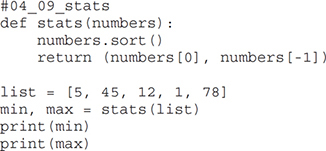
This method of finding the minimum and maximum is not terribly efficient, but it is a simple example. The list is sorted and then we take the first and last numbers. Note that numbers[-1] returns the last number because when you supply a negative index to an array or string, Python counts backward from the end of the list or string. Therefore, the position -1 indicates the last element, -2 the second to last, and so on.
Exceptions
Python uses exceptions to flag that something has gone wrong in your program. Errors can occur in any number of ways while your program is running. A common way we have already discussed is when you try to access an element of a list or string that is outside of the allowed range. Here’s an example:

If someone gets an error message like this while they are using your program, they will find it confusing to say the least. Therefore, Python provides a mechanism for intercepting such errors and allowing you to handle them in your own way:

We cover exceptions again in the next chapter, where you will learn about the hierarchy of the different types of error that can be caught.
Summary of Functions
This chapter was written to get you up to speed with the most important features of Python as quickly as possible. By necessity, we have glossed over a few things and left a few things out. Therefore, this section provides a reference of some of the key features and functions available for the main types we have discussed. Treat it as a resource you can refer back to as you progress though the book, and be sure to try out some of the functions to see how they work. There is no need to go through everything in this section—just know that it is here when you need it. Remember, the Python Shell is your friend.
For full details of everything in Python, refer to http://docs.python.org/py3k.
Numbers
Table 4-1 shows some of the functions you can use with numbers.
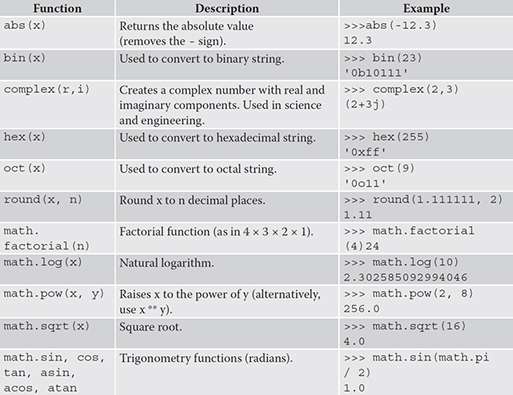
Table 4-1 Number Functions
Strings
String constants can be enclosed either with single quotes (most common) or with double quotes. Double quotes are useful if you want to include single quotes in the string, like this:
s = "Its 3 o'clock"
On some occasions you’ll want to include special characters such as end-of-lines and tabs into a string. To do this, you use what are called escape characters, which begin with a backslash () character. Here are the only ones you are likely to need:
![]()
Tab character
![]()
Newline character
Table 4-2 shows some of the functions you can use with strings.

Table 4-2 String Functions
Lists
We have already looked at most of the features of lists. Table 4-3 summarizes these features.
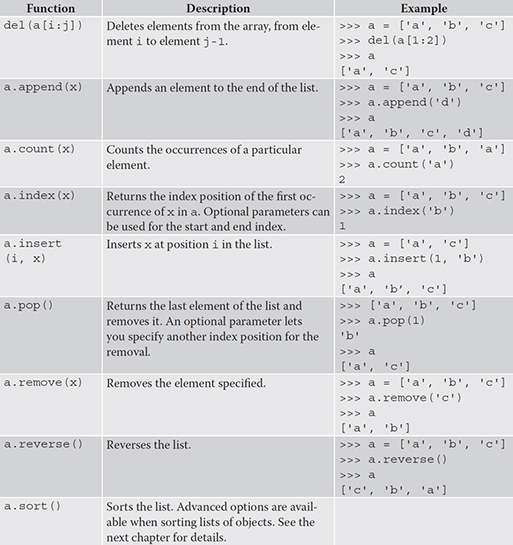
Table 4-3 List Functions
Dictionaries
Table 4-4 details a few things about dictionaries that you should know.

Table 4-4 Dictionary Functions
Type Conversions
We have already discussed the situation where we want to convert a number into a string so that we can append it to another string. Python contains some built-in functions for converting items of one type to another, as detailed in Table 4-5.

Table 4-5 Type Conversions
Summary
Many things in Python you will discover gradually. Therefore, do not despair at the thought of learning all these commands. Doing so is really not necessary because you can always search for Python commands or look them up.
In the next chapter, we take the next step and see how Python manages object orientation.
